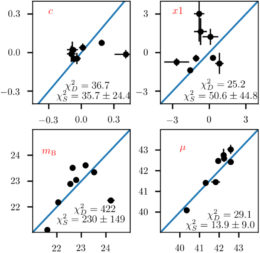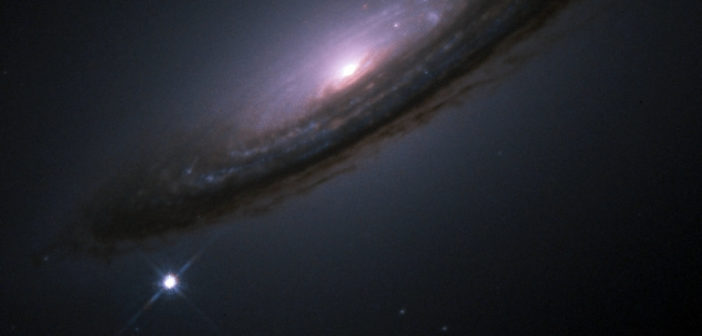What can we learn about the large-scale properties of our universe from Type Ia supernovae — cosmic flashes thought to be caused by the explosions of white dwarfs? The answer may depend on the shared traits of pairs of supernova siblings.
Standardizable Candles

This artist’s rendering depicts the typical Type Ia supernova mechanism, in which a white dwarf siphons mass from its companion, exceeds the Chandrasekhar mass, and explodes. [NASA/CXC/M. Weiss]
By comparing the measured brightness of these explosions to their expected intrinsic luminosity, we can obtain a quantity known as the distance modulus, which tells us how far away the supernova occurred.
But there’s a catch: though Type Ia supernovae all have roughly the same intrinsic luminosity, they still exhibit some variation — scatter — in their natural peak brightness. This intrinsic scatter reduces how accurately we can measure their distance.
Taking the Blame for Scatter
Astronomers are still working to understand what causes the intrinsic scatter in supernova distance modulus. Is it differences in the atmospheres of the white dwarfs that exploded? Or variations in the explosion process?
Another possibility is that variations in the host galaxy environment could impact the observed supernova signal. This would be important: since galaxy properties evolve with redshift, that means that if host galaxy properties do influence the supernova signals we see, we’d need to account for this when we infer supernova distances.

The locations of the eight pairs of Type Ia supernova siblings found by the authors in the DES-SN data set, marked in red and yellow on images of the eight host galaxies. Each plot is 16”x16”. [Scolnic et al. 2020]
On The Hunt for Siblings
Supernovae are rare — a typical galaxy only hosts a few per century. But with modern supernova surveys, we can monitor millions of galaxies over multiple years, collecting many observations of these explosions.
Scolnic and collaborators leveraged one such survey, the Dark Energy Survey Supernova Program (DES-SN) conducted at the Cerro Tololo Inter-American Observatory in Chile, to find eight parent galaxies that each hosted two Type Ia supernovae during the survey.
The authors then examined the light curves of these supernovae to see if these sibling pairs had more light-curve properties in common than a random pair of two supernovae drawn from a simulated set.
Expanding the Supernova Crowd

Plots show the comparison of different light curve parameters (c, x1, and mB) and the distance modulus µ, for each of the eight pairs of matched sibling supernovae. The authors’ results show that the light curves of sibling pairs are not much more alike than those of random pairs. [Scolnic et al. 2020]
Though these results are based on just eight pairs of supernova siblings, more robust findings will be possible in the future! The Vera Rubin Observatory (formerly LSST) is expected to detect ~100 times this number of Type Ia supernova pairs, vastly increasing our sample size and further allowing us to more accurately measure the cosmological properties of the universe.
Citation
“Supernova Siblings: Assessing the Consistency of Properties of Type Ia Supernovae that Share the Same Parent Galaxies,” D. Scolnic et al 2020 ApJL 896 L13. doi:10.3847/2041-8213/ab8735
